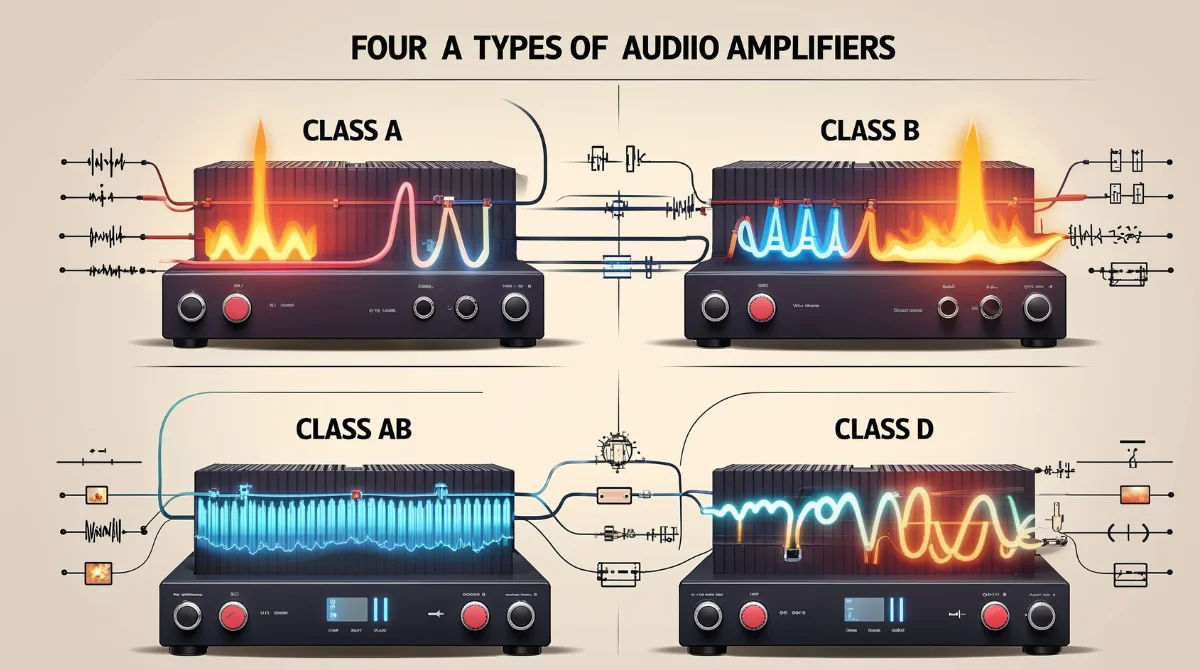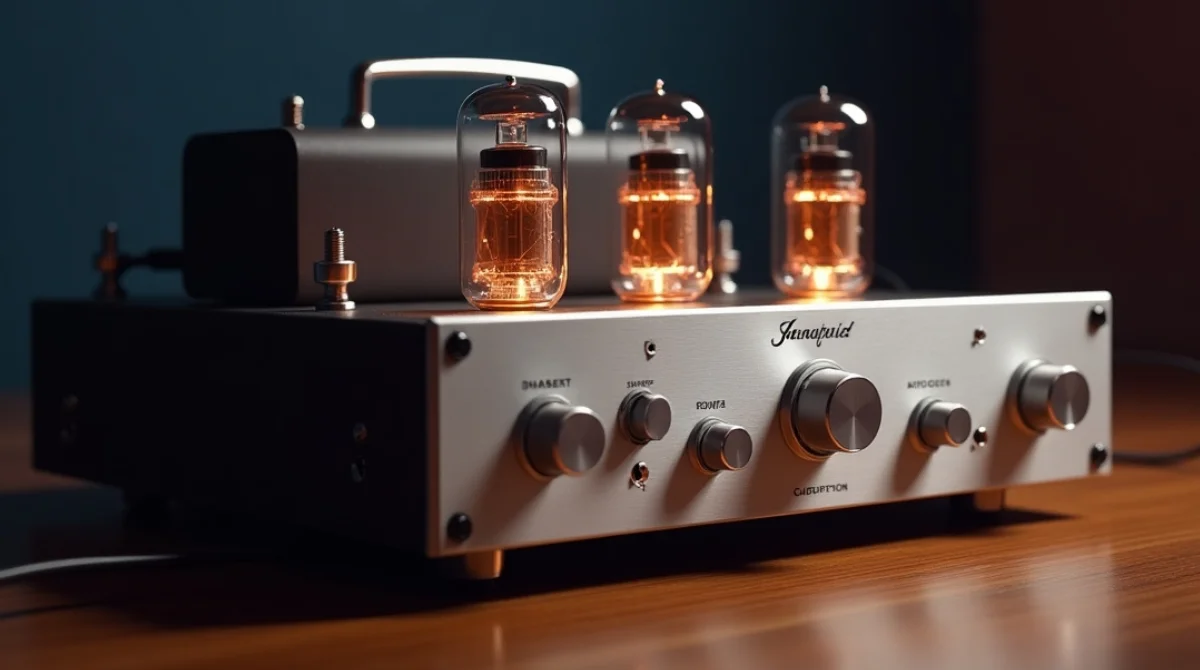An amplifier is an electronic device that increases the strength of a signal. In everyday terms, it’s what makes your music louder, your TV sound clearer, and your voice heard through a microphone. Whether it’s in your car, home theater, or smartphone, amplifiers play a crucial role in enhancing audio experiences.
How Does an Amplifier Work?
At its core, an amplifier takes a weak electrical signal and boosts it using power from a source, like a battery or wall outlet. This process involves components like transistors, which act like valves controlling the flow of electricity. When a small input signal enters the amplifier, the transistor allows more current to flow, producing a stronger output signal that drives speakers or other devices.
Types of Amplifiers

Amplifiers come in different types, and each one works a little differently depending on what it’s used for. Some are built for the best sound quality, while others are designed to save power or stay cool. Let’s explore the most common types:
1. Class A Amplifiers
Class A amplifiers are known for delivering the best sound quality. They are always “on,” which means they keep working even when there’s no sound coming through. This constant operation helps avoid distortion, so the sound stays clean and accurate. However, because they’re always running, they use a lot of electricity and get hot quickly. These amplifiers are often found in expensive, high-end audio systems where sound quality is more important than energy efficiency. They’re preferred by audiophiles who want the purest sound.
2. Class B Amplifiers
Class B amplifiers are more efficient than Class A because they only work during half of the signal wave one part handles the positive half, and the other handles the negative half. This design saves energy and reduces heat. However, there’s a small problem: when the signal switches between halves, it can cause a bit of distortion, known as “crossover distortion.” This makes Class B amps less popular, especially where sound quality matters. They are still useful in some applications where power savings are more important than perfect audio.
3. Class AB Amplifiers
Class AB amplifiers try to combine the strengths of both Class A and Class B. They work most of the time like a Class A amplifier to give good sound quality, but switch to Class B mode during louder or more demanding signals to save energy. This blend helps reduce the distortion seen in Class B amps and also cuts down on the energy waste seen in Class A amps. That makes Class AB amplifiers a popular choice for home stereos, car audio systems, and other mid- to high-end sound equipment. They give you good sound without needing a cooling fan or massive power supply.
4. Class D Amplifiers
Class D amplifiers are often called digital amplifiers, even though they are technically analog. These amplifiers are very efficient because they work by turning on and off very quickly like a light switch flicking on and off thousands of times per second. This switching method wastes less energy as heat, which means the amp stays cooler and can be made smaller. That’s why Class D amps are found in portable Bluetooth speakers, modern home audio systems, and even some smart devices. Although they used to have a reputation for lower sound quality, today’s Class D amplifiers sound excellent and are widely used.
Each amplifier type has its own strengths and weaknesses, and the right one depends on what you’re using it for. If you want the best sound and don’t mind using more power, go with a Class A. If you care about saving power and space, a Class D might be best. For a balance between the two, Class AB is a smart middle-ground. Understanding these types can help you make better decisions when buying audio equipment or designing sound systems.
Common Uses of Amplifiers
Amplifiers are all around us, even if we don’t always notice them. They help make sounds louder and clearer, and they’re built into many of the devices we use every day. Here are some common ways amplifiers are used in our daily lives:
1. Home Audio Systems
When you listen to music or watch a movie at home, you want the sound to be rich and powerful. That’s where amplifiers come in. Whether it’s a TV, music player, or home theater system, amplifiers help take the sound signal and make it stronger so your speakers can deliver clear, high-volume audio. Without amplifiers, the sound would be weak and hard to hear, especially in larger rooms.
2. Car Audio Systems
If you’ve ever turned up the music in your car and felt the bass shake the seats, thank the amplifier. Car audio systems use amplifiers to boost the sound signal from your stereo to the speakers. This allows you to hear crisp vocals and deep bass even with road noise in the background. A good amplifier ensures your driving experience is not just smooth, but also filled with great sound.
3. Musical Instruments
Musicians often use amplifiers to make their instruments loud enough for an audience to hear. Electric guitars, bass guitars, and keyboards don’t produce much sound on their own they need amplifiers to project their music. These amplifiers are specially designed to handle musical tones and effects, making them a key part of any live performance or recording studio.
4. Public Address (PA) Systems
In places like schools, stadiums, airports, and event halls, microphones are connected to amplifiers to make sure everyone can hear the speaker clearly. These systems are called public address systems or PA systems. Without amplifiers, a speaker’s voice would not reach a large audience, especially in open or noisy environments. Amplifiers help make announcements and speeches loud and understandable, even in big spaces.
5. Mobile Devices
Even our smartphones and tablets have tiny amplifiers built into them. These small yet powerful components help drive the speakers and earphones so we can enjoy music, videos, and calls with clear sound. While the amplifiers in mobile devices are much smaller than those in home or car systems, they play the same important role turning a small audio signal into something we can hear easily.
6. Choosing the Right Amplifier
Picking the right amplifier isn’t just about getting the loudest sound it’s about finding the one that fits your purpose best. Different amplifiers are built for different jobs, so knowing what you need helps you make a smarter choice. Here are some helpful guidelines to choose the best amplifier for your needs:
7. For High-Quality Sound
If you’re someone who really cares about sound quality, like a music lover or an audiophile then Class A or Class AB amplifiers are your best options. These amplifiers are designed to deliver clear, detailed, and rich audio. Class A amplifiers, in particular, are known for producing the purest sound, although they use more power and get hotter. Class AB amplifiers offer a nice balance they give you excellent sound quality without wasting as much energy, which makes them popular in home stereo systems and car audio setups.
8. For Energy Efficiency
If saving power or using a battery-powered device is your priority, then Class D amplifiers are a great choice. These are highly efficient, meaning they use less electricity and generate very little heat. That’s why they’re perfect for portable devices like Bluetooth speakers, mobile phones, and even smart home gadgets. Over time, Class D amplifiers have also improved in sound quality, so you don’t have to sacrifice good audio just to save energy.
9. For Musical Instruments
If you’re playing an electric guitar, keyboard, or bass, then you’ll want an amplifier made specifically for musical instruments. These are not just regular amplifiers they are tailored to bring out the unique tones and effects that instruments need. For example, a guitar amplifier can shape the sound with built-in effects like reverb, distortion, and equalizers. Keyboard amplifiers, on the other hand, are designed to handle a wide range of sounds clearly. Choosing an instrument-focused amp ensures your music sounds just the way it should, whether you’re practicing at home or performing on stage.
Future Outlook
The future outlook of amplifiers in the coming years is shaped by technological advancements and evolving consumer demands. Here’s a breakdown of the trends and developments that are expected to influence the amplifier industry:
1. Integration with Smart Devices
As more devices become interconnected, amplifiers will increasingly be integrated into smart home ecosystems. With the rise of smart speakers, home theaters, and voice-activated systems, amplifiers will play a central role in enhancing audio quality across various smart devices, offering seamless connectivity and improved sound experiences.
2. Advancements in Class D Technology
The shift towards Class D amplifiers is expected to continue as demand for more energy-efficient and compact solutions grows. With the ability to operate with less power consumption and produce less heat, Class D amplifiers will be increasingly used in portable devices like Bluetooth speakers, headphones, and personal audio systems. This trend is driven by consumers’ need for portability without compromising sound quality.
3. Improved Sound Quality and Fidelity
As consumers become more discerning about audio quality, amplifiers will evolve to provide even clearer, more dynamic sound. The demand for high-fidelity sound systems will push manufacturers to incorporate cutting-edge technologies, such as digital signal processing (DSP) and high-resolution audio capabilities into amplifiers, ensuring they meet the needs of audiophiles and professional sound systems.
4. Miniaturization and Portability
There will be continued demand for smaller, lighter amplifiers that don’t compromise on performance. Miniaturization will be a key trend, particularly for portable audio equipment. As smartphones, tablets, and wearables continue to become central to everyday life, amplifiers will need to fit into these devices without sacrificing their sound power. Smaller amplifiers will also be essential for compact home audio systems and car audio solutions.
5. Wireless and Bluetooth Amplifiers
With the rise of wireless audio technologies like Bluetooth and Wi-Fi, the future of amplifiers will see a stronger focus on wireless connectivity. Bluetooth amplifiers will continue to dominate the portable audio sector, providing consumers with the flexibility to enjoy high-quality sound without the need for cables. In home and car audio systems, Wi-Fi-enabled amplifiers will enable seamless streaming and connection to multiple devices.
6. Sustainability and Eco-Friendly Solutions
As environmental awareness increases, eco-friendly amplifiers will gain traction. The focus will be on creating amplifiers with low energy consumption, longer life cycles, and recyclable components. Consumers are likely to seek out amplifiers from brands that emphasize sustainability in their products, which could lead to the development of more energy-efficient systems, such as solar-powered amplifiers for outdoor and remote use.
7. AI and Machine Learning Integration
Amplifiers of the future may incorporate artificial intelligence (AI) to enhance the user experience. AI could be used for automated sound adjustments, real-time tuning, and even noise cancellation. These smart amplifiers would automatically adapt to different listening environments, making them ideal for home theaters, concert halls, or even personalized audio experiences in headphones.
8. Customized Sound Profiles
Consumers will increasingly demand amplifiers that allow for personalized audio experiences. Amplifiers may come with advanced features to customize sound profiles based on individual preferences, hearing abilities, or the acoustics of specific environments. This trend is already visible in high-end home audio systems and is expected to grow as more consumers seek tailored audio solutions.
9. Growth in Professional Audio Systems
In professional audio settings, such as concert venues, theaters, and live events, amplifiers will continue to evolve to meet the demands of larger, more complex sound systems. The need for higher output power, clearer sound reproduction, and durability will drive the development of more powerful and versatile amplifiers suited to professional audio equipment.
10. Hybrid and Multi-Channel Amplifiers
With the continued rise of surround sound systems and immersive audio experiences, there will be a growing demand for multi-channel amplifiers that can support 5.1 or 7.1 channel audio systems. These amplifiers will provide an enriched audio experience for home theaters, gaming systems, and high-end audio setups, while also integrating easily with virtual and augmented reality applications.
Conclusion
Amplifiers play a vital role in improving sound quality across many devices, from home theaters and car stereos to musical instruments and mobile gadgets. By boosting weak signals, they make audio louder, clearer, and more enjoyable. Knowing the different types, like Class A for premium sound, Class D for efficiency, and specialized amps for instruments helps you choose the right one for your needs. Whether you’re a music lover, a performer, or simply want better sound in daily life, understanding amplifiers lets you enjoy audio the way it was meant to be heard powerful and precise.



